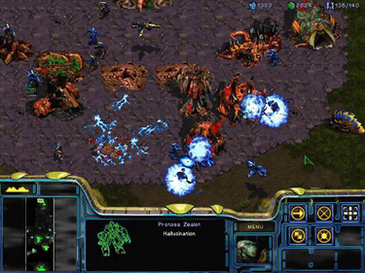Released in 1998, StarCraft was the first strategy game I have ever played on a PC. I installed this on my machine primarily because I was intrigued by this game, as it had become a conversational topic everywhere in school. Back then, I only played role-playing games like Diablo and Heroes of Might and Magic, and simulation games like Sim City. I didn't find real-time strategy games interesting at all.
My opinion changed entirely when I played StarCraft for the very first time. It was partly because StarCraft was designed by Blizzard and Diablo was then my favorite PC game. But the game play was really its big edge over other games of the same genre.
StarCraft's gameplay centers on acquiring and gaining control over two important resources: minerals and vespene gas. These resources are harvested by worker units. These resources are kept in the Command Center, although a refinery is required to use the harvested vespene gas.
Meanwhile, acquired resources allow building of structures, training of units and upgrade of skills, abilities and units. Some constructed buildings allow the creation of new units, while others upgrade the players' forces or allow more advanced units or structures to be built. Each of a player's units demands a certain quantity of supply, which is provided by buildings or units particular to each race. Players must maintain enough supply to support their forces, lest they become temporarily unable to produce additional units. In standard games, the maximum amount of supply that can be used at any time for each controlled race is two hundred, limiting the total number of units any player may have.
The selection of units available to each species defines its racial identity. Protoss marshal powerful and expensive warriors and machinery, while Zerg rely on sheer numbers and speed to overwhelm their opponents. Terrans are the versatile and flexible alternative to both races, relying on fragile but powerful units that can be very effective when used in formations. No species has an innate advantage over any other. The balance between species has been the subject of numerous gameplay tweaks introduced via infrequent updates.
Resource management, expansion to control resource locations, and effective offensive and defensive combat tactics are key to victory. In order to excel, players must develop the ability to perform both micro- and macro-management simultaneously. Micromanagement includes moving units into certain formations and maneuvering them on the map or in battle, while using their different combinations of abilities and numbers to full advantage. This unique skill requirement distinguishes StarCraft from many other, more modern real-time strategy games, the latter performing many of the strategic organizational arrangements with active assistance from the game's artificial intelligence.
Wednesday, March 19, 2008
Remembering StarCraft
Labels:
Classic Games,
Games,
StarCraft
Subscribe to:
Post Comments (Atom)






No comments:
Post a Comment